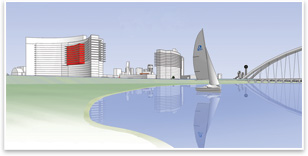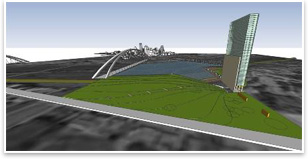
HKS Design Fellowship Links Young Designers with Community by Tracy Ostroff How do you . . . link young architects with political leaders and solve community challenges all at the same time? Summary: HKS launched the HKS Design Fellowship program two years ago to expand opportunities for the firm’s young professionals and bring them together with civic leaders to show how good design can be used to solve challenges and shape communities. For the first two years, HKS focused on projects in Dallas, where the large firm has its headquarters. The long-term goal of the HKS Design Fellowship is to add other cities in which HKS has offices. This year, in addition to a Dallas charrette, the firm will expand the program to Detroit.
HKS Director of Design Dan Noble, FAIA, explains that the 2007 two-and-a-half-day charrette dealt with the Trinity River Park project, during which participants in the design fellowship focused on how the community could better leverage the Trinity River Park. Architects were asked to envision the development of key sites that will promote access to the proposed park. The group—council members, civic leaders, the HKS architects, and other community members from both sides of a debate about the project—reviewed the challenges of addressing views, green development, access, circulation, and the project as a catalyst for new development. “The cumulative impact of this program is reaching out to the community,” says Shannon Kraus, AIA, HKS vice president and chair of the HKS Design Fellowship. “The feedback has been outstanding. Parties come in reticent, but come out energized.” Most importantly, Kraus notes, it allows a positive connection with civic leaders in the community. “Younger architects get exposed to creating relationships with political leaders and better understand the power of design in shaping communities.” Showing leadership
“Instead of waiting to be invited to the table, we are showing leadership by organizing the program,” Kraus notes. “The program positions the architects and the firm as problem-solvers and resources for the community. The design fellowship also helps the designers build relationships with people with whom we might otherwise not have had access. However small, at the end of the day, we have had a bit of influence.” The design fellowship program is just one of the firm’s pro bono efforts. “Architects can and should play a more active role in community-based issues,” Kraus says.
The process also offers an enculturation into the firm’s design ethic and philosophies and an opportunity to break bread with people from all over the HKS family. The community is appreciating the firm’s efforts as well. “Word is getting out through the city that this fellowship has opened people’s eyes,” Noble reports. |
||
Copyright 2008 The American Institute of Architects. All rights reserved. Home Page |
||
home
news headlines
practice
business
design
recent related
› AIA Teams Up with Google to Launch New Architecture Layers in Google Earth
HKS Design Fellowship program participants developed big-picture concepts for three key adjacent sites including Reunion Arena (#1) and Oak Cliff Gateway (#2 and 3). Graphics courtesy HKS Inc.

 In 2006, the fellowship addressed the Woodall Rodgers Deck Park,
for which the charrette developed plans to knit four disparate districts
in the downtown Dallas area into a cohesive whole. Imperative to
the city’s growth, the plans developed during the charrette offered a way for people to walk among the areas and better move around the downtown.
In 2006, the fellowship addressed the Woodall Rodgers Deck Park,
for which the charrette developed plans to knit four disparate districts
in the downtown Dallas area into a cohesive whole. Imperative to
the city’s growth, the plans developed during the charrette offered a way for people to walk among the areas and better move around the downtown. The firm selects the 30 or so younger architects for the Design
Fellowship Program from informal nominations from peers and firm
leaders. The designers come from all offices. It’s offered as a perk, with the firm covering costs and the employee donating his or her time to the project.
The firm selects the 30 or so younger architects for the Design
Fellowship Program from informal nominations from peers and firm
leaders. The designers come from all offices. It’s offered as a perk, with the firm covering costs and the employee donating his or her time to the project. Design for design’s sake
Design for design’s sake